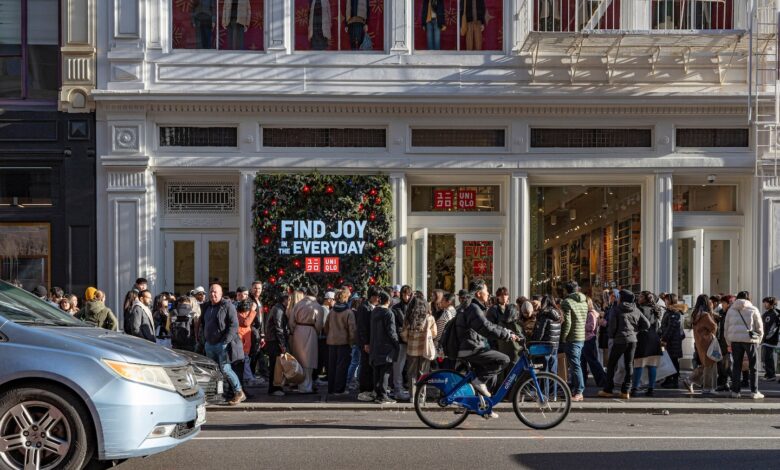Cyber Monday, Black Friday weekend break spending records

Consumers spent $38 billion online over the five-day period, according to data from Adobe Analytics, a 7.8 percent increase over last year. Cyber Monday remains the hottest shopping day of the season, with consumers surpassing Adobe’s projections and shelling out $12.4 billion, a 9.6 percent year-over-year jump. Sales on Black Friday ticked up 7.5 percent to a record $9.8 billion.
U.S. shoppers also spent on Thanksgiving and the weekend, with sales hitting $5.6 billion and a combined $10.3 billion on Saturday and Sunday.
Those strong numbers, however, are more modest once adjusted for inflation. In October, consumer prices excluding volatile components like food and energy rose 4 percent over October 2022. That’s far lower than the high of 9.1 percent recorded in June 2022, but still well above the Federal Reserve’s target of 2 percent.
A record 200.4 million people shopped over the five-day period, according to the National Retail Federation. And more consumers than ever shopped online, coming in at 134.2 million. More than half of them used their mobile devices, according to Adobe.
Consumers found better deals online, said Marshal Cohen, the chief retail analyst at market research firm Circana, where it’s easier for them to assess the discounts and compare prices.
“Layer on the increasing power of the younger generations and their propensity to shop online, and we have a new holiday shopping dynamic,” Cohen said in a statement.
The highest-performing shopping categories were clothing and accessories, toys, gift cards, books, video games and other media, and — for the first time — personal care and beauty, according to Phil Rist, the executive vice president of strategy at Prosper Insights and Analytics.
Meanwhile, buy now, pay later options — which allow consumers to pay off items in installments — saw staggering growth over the five-day event, with a 42.5 percent surge in usage year-over-year, contributing $940 million to online spending, according to Adobe. From Nov. 1 through Cyber Monday, buy now, pay later drove a total increase of $8.3 billion, a 17 percent jump from 2022.
“It’s an example of the market being responsive to consumer needs and expectations — giving them flexibility, giving them an opportunity to manage their budgets, their spending, and do controlled purchases over time that fit for themselves and their families,” said Matthew Shay, president and chief executive of the NRF.
It’s also a sign that consumers are having to find more creative ways to finance their holiday shopping, which many Americans consider a necessity.
Economists and policymakers are paying close attention to holiday spending this year, looking for signs that consumers are buckling under the pressure of stubborn inflation, rising debt levels and higher interest rates. Analysts, industry groups and some of the nation’s largest retailers are seeing signs that Americans are scaling back.
Consumers have been remarkably resilient, aided by a hot labor market, wage growth and a cache of savings accrued during the pandemic. But in October, hiring cooled and retail sales fell for the first time since March amid a pullback in big-ticket purchases like cars and furniture. Student loan payments also resumed last month. And consumer confidence is waning in the face of an opaque macroeconomic environment.
Despite promising sales numbers, retailers are cautious about consumer turnout through the rest of the year. The National Retail Federation projects spending will grow 3 to 4 percent in November and December — a slower pace than years past.
“Growth has been muted overall and looks to be more modest than previous years,” Saunders said. “This means the final results will be mixed, with some retailers doing well and others faring badly.”
Some of the nation’s largest retailers, many of which reported third-quarter earnings this month, are expressing caution. Walmart executives told investors that Americans are continuing to pull back on discretionary spending, adding that health, wellness and grocery sales outperformed general merchandise. Best Buy, Lowe’s and Kohl’s lowered their full-year financial forecasts.
“There’s no question that there’s been some moderation and deceleration in consumption relative to the last 36 months as consumers work their way through the pandemic bonus checks, all the savings as other parts of the economy open,” Shay said.
Consumer trends indicate that shoppers are showing signs of price fatigue, relying more on discounts and sales. Retailers have to weigh their margins against fighting for their share of the consumer’s wallet, said Katie Thomas, who leads the Kearney Consumer Institute, an internal think tank at global strategy and management consulting firm Kearney.
“Consumers remain in the driver’s seat in retail and are increasingly thoughtful and even strategic about where and how they’ll spend their money,” Thomas said in a statement.





